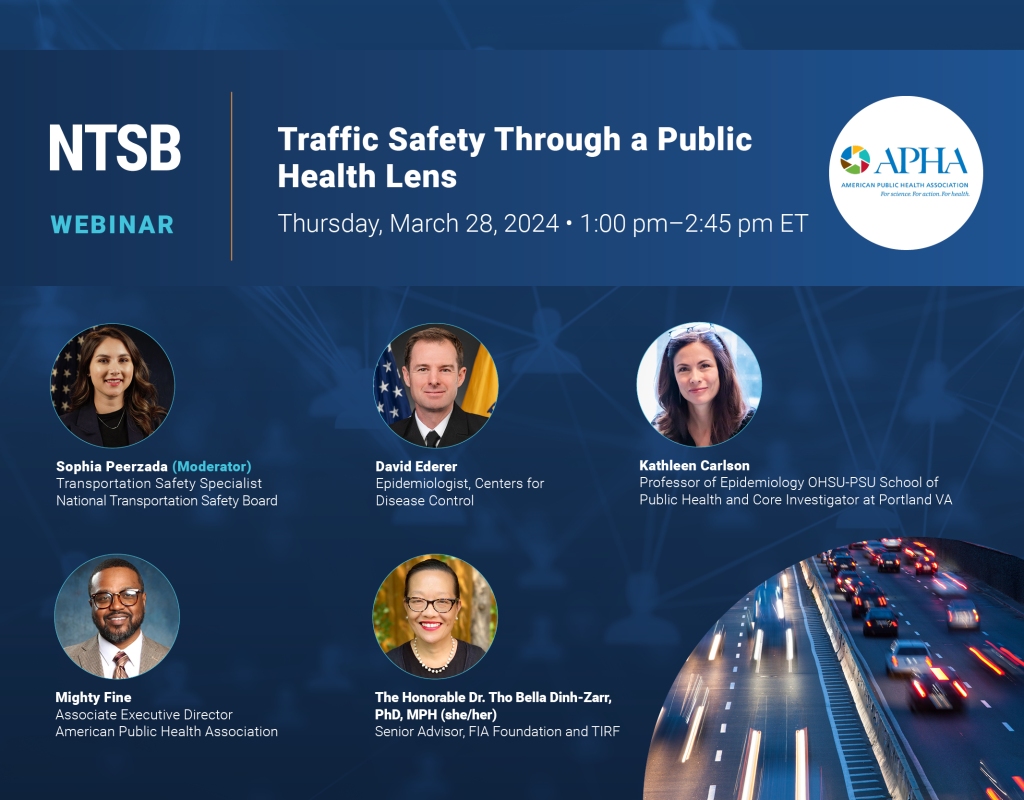By Sophia Peerzada, Safety Advocate
On March 28th, I moderated a webinar titled “Traffic Safety Through a Public Health Lens.” This joint effort between the NTSB and the American Public Health Association (APHA) ahead of National Public Health Week highlighted traffic safety as a public health issue.

This topic is very important to me as a transportation safety advocate with a degree in public health. When I was studying for my Master of Public Health degree at the University of South Florida, I was the only student in my program (that I knew of) who was interested in traffic safety. I was motivated by the Tampa Bay region’s regrettably high rates of traffic-related fatalities, and the perceptible imbalance of safety interventions along socioeconomic lines. I also knew the statistics nationwide: each year, 43,000 people die on US roadways. I thought, of course this is a public health issue—people are getting hurt and dying on our roads each day!
Since joining the NTSB in November 2023, I have had the pleasure of meeting folks who bring a public health mindset to transportation safety. In fact, the NTSB itself plays a significant role in public health by identifying transportation safety issues and issuing recommendations to make travel safer for the public.
Prior to the webinar, I connected with former NTSB Vice Chair T. Bella Dinh-Zarr, who notably referred to traffic fatalities as an “epidemic on wheels.” Of course, I was thrilled when Dr. Dinh-Zarr and public health colleagues Dr. Kathleen Carlson, Dr. David Ederer, and Dr. Mighty Fine agreed to be panelists on this first-of-its-kind webinar.
Each panelist brought an invaluable perspective to the conversation.
Dr. Carlson, a professor of epidemiology at the Oregon Health and Science University-Portland State University School of Public Health and core investigator at the Portland VA, opened the event with a review of injury epidemiology. She explained that “public health takes a scientific approach to a public health problem” as it seeks to identify the problem’s cause and develop strategies for preventing it from happening again.
Dr. Ederer, an epidemiologist at the CDC’s Physical Activity and Health Branch, followed with a presentation on the Safe Systems Pyramid and how public health principles can be applied to engineering. His presentation underscored the need to apply traffic safety interventions systematically to improve population health.
Dr. Dinh-Zarr, Senior Advisor at FIA Foundation and the Traffic Injury Research Foundation, built upon Dr. Carlson’s and Dr. Ederer’s presentations by providing concrete examples of how the public health lens has been applied to traffic safety efforts. She highlighted the NTSB’s investigation process as an example of taking a public health approach to preventing the recurrence of traffic-related injuries and fatalities.
Finally, Dr. Fine, associate executive director of the APHA’s Division of Public Health Policy & Practice, rounded out the panel by emphasizing the need to apply a health equity perspective to all traffic safety efforts. He urged traffic safety practitioners to ensure that interventions are inclusive, accessible, and culturally relevant.
Overall, it was a wonderful and much-needed discussion that I am certain each attendee walked away from having learned something new. Dr. Ederer said it best in his presentation: “Public health is a way of describing and solving problems.” Given that, I think all of us in the traffic safety space are public health practitioners.
You can view the full webinar recording here: https://youtu.be/DMNxSFNANeI?si=FDR2BhF6vZXdJDut..





